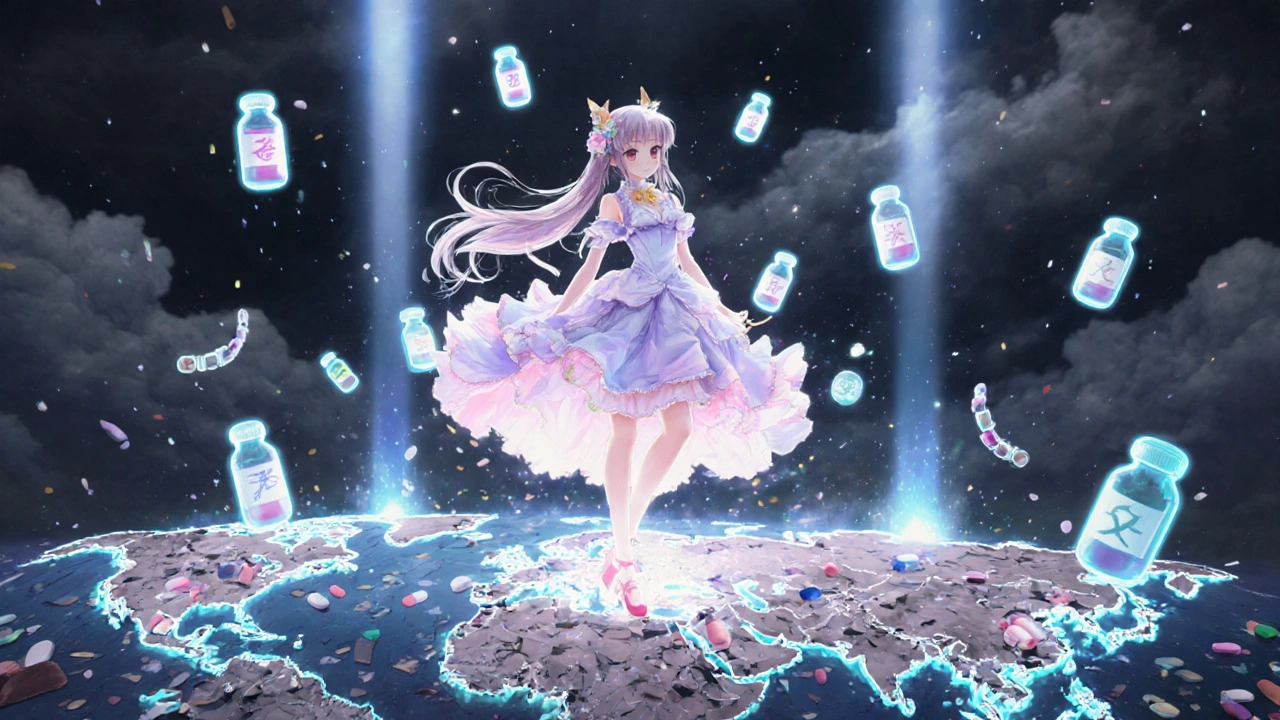 Nov, 21 2025
Nov, 21 2025
When you pick up your prescription, you probably don’t think about where that pill came from. But 90% of the active ingredients in U.S. drugs are made overseas-mostly in China and India. And when those supply chains glitch, people don’t just miss their meds. They risk their lives. In 2024, over 100 critical drugs, including antibiotics, cancer treatments, and heart medications, faced nationwide shortages in the U.S. alone. The root cause? A decades-long reliance on foreign manufacturing that’s now cracking under pressure.
How Did We Get Here?
It started with cost-cutting. In the 1990s and 2000s, pharmaceutical companies moved production overseas because labor and regulatory costs were lower. China became the world’s largest supplier of active pharmaceutical ingredients (APIs), producing nearly 40% of the global total. India, with its strong generic drug industry, took over finished dosage forms. Together, these two countries now supply over 70% of the world’s generic medicines. The logic was simple: make it cheaper, sell it cheaper. But no one planned for what happens when a port shuts down, a factory gets hit by floods, or political tensions spike. By 2025, 94% of multinational drugmakers admit their raw material sourcing is the most vulnerable part of their supply chain, according to the National Foreign Trade Council. And it’s not just about price anymore-it’s about survival.The Real Cost of One-Source Dependence
Relying on one country for your most critical ingredients is like putting all your eggs in one basket-and then leaving the basket in a storm zone. In 2020, when China locked down early in the pandemic, the U.S. ran out of heparin, a blood thinner. In 2023, a factory fire in India disrupted production of metformin, a common diabetes drug. Both shortages lasted over six months. Lead times from Asia to the U.S. have increased by 50% since 2019. That means if a factory in Shanghai shuts down, it takes months-not weeks-to find an alternative. Meanwhile, U.S. drugmakers had cut inventory buffers to the bone to save money. Now, they’re scrambling. McKinsey reports that just-in-case inventory levels have risen by 15% since 2022, but most companies still aren’t keeping enough. The result? Hospitals rationing insulin. Cancer patients delaying chemo. Emergency rooms using outdated, less effective alternatives because the new ones aren’t available. The FDA recorded over 300 drug shortages in 2024-the highest in a decade. And it’s not just the U.S. Europe and Canada saw similar spikes.Why Reshoring Isn’t Easy
The obvious fix? Bring production home. But it’s not that simple. Manufacturing APIs requires specialized chemical plants, strict FDA-style oversight, and a workforce trained in high-precision synthesis. The U.S. hasn’t built a new API plant in over 15 years. Wages in the U.S. are nearly five times higher than in China for comparable roles, according to IMD Business School. Setting up a domestic facility costs 22% of a company’s annual procurement budget, per Plante Moran’s 2025 analysis. And it takes 18 to 24 months just to get a new plant licensed and running. Some companies tried it. One mid-sized U.S. maker of antibiotics spent $120 million to reopen a shuttered facility in Pennsylvania. It took two years. They now produce 20% of their volume domestically-but it’s 40% more expensive. They had to raise prices. Patients noticed.
The New Strategy: Multi-Shoring
Instead of going back to the U.S. or staying in Asia, smart companies are doing something smarter: spreading out. This is called multi-shoring. It means making the same drug ingredient in three places-say, India, Mexico, and Poland-so if one fails, the others pick up the slack. By 2025, 50% of major pharma firms are shifting to this model, according to IDC. The payoff? A 10-point increase in supply reliability. Companies using multi-shoring report 65% fewer disruption days per year than those still tied to single-source suppliers. Mexico is becoming a key player. Transportation costs from Mexico to the U.S. are 30-40% lower than from China. Labor is cheaper than in the U.S. And under the updated USMCA trade deal, starting in early 2025, tariffs on pharmaceutical inputs from Mexico are locked in at 0%. One Fortune 500 medical device maker cut its lead times from 45 days to 12 by moving API production to Monterrey. Their on-time delivery rate jumped to 99.2%. But it’s not cheap. Setting up a second or third production line adds 15-20% to labor costs. And you need more quality control teams. That’s why only 40% of Asian-based manufacturers had adopted multi-shoring by the end of 2024. But the ones who didn’t? They’re still waiting for their next crisis.Digital Tools Are the Game Changer
Technology isn’t just helping-it’s becoming essential. Companies that use AI to predict supply risks, blockchain to verify ingredient origins, and digital twins to simulate disruptions are surviving better than ever. One U.K.-based generics maker started using AI forecasting in 2023. It flagged a potential API shortage in India three months before it happened. They switched suppliers, rerouted shipments, and avoided a 30-day outage. Their competitors? They ran out. Digital twins-virtual models of real-world supply chains-are now used by 68% of large pharma firms, up from 22% in 2020. These tools let companies test what happens if a port closes or a supplier goes bankrupt. They can see the ripple effects before they happen. And blockchain? It’s cutting quality disputes by 65%. When a batch of API arrives, you can trace every step-from the raw chemicals to the final capsule. No more guessing if it’s clean. No more blaming the wrong supplier.
Who’s Getting Left Behind?
Small and mid-sized manufacturers are in trouble. They don’t have the cash to build multiple factories or buy AI systems. Yet they make 90% of the generic drugs used in clinics and nursing homes. A 2025 survey by Supply Chain Dive found that 60% of small pharma firms couldn’t afford to diversify suppliers. Many are still locked into long-term contracts with Chinese vendors because switching means upfront costs they can’t cover. The result? They’re the first to run out of stock when trouble hits. Even worse, 33% of global drug companies report being understaffed in supply chain roles. There aren’t enough people who understand both pharmaceutical regulations and international logistics. And cybersecurity? 60% of manufacturers say they’re worried about hackers targeting their supply chain data. One breach could fake a shipment’s origin-or worse, poison a batch.What Needs to Change
The system isn’t broken because of bad actors. It’s broken because we treated supply chains like a spreadsheet line item, not a lifeline. Governments need to step in. The U.S. passed the 2024 Drug Supply Chain Security Act, which requires better tracking. But it doesn’t fund domestic production. The EU has started subsidies for API manufacturing-but only for companies that commit to multi-shoring. The World Health Organization now recommends that all countries maintain at least 6 months of critical drug stockpiles. Only 12 countries do. The U.S. has less than 3 months for most antibiotics. And consumers? They need to understand that cheaper drugs today might mean no drugs tomorrow. If you’re paying $5 for a generic pill, ask: Who made it? Where? And what happens if that factory goes dark?The Bottom Line
International supply chains aren’t going away. But the days of betting everything on one country are over. The drug shortages we’re seeing now aren’t accidents. They’re predictable outcomes of a system built for profit, not resilience. The future belongs to companies that diversify suppliers, invest in digital tools, and treat their supply chains like the public health infrastructure they are. The ones that don’t? They’ll keep losing patients-not just sales.Why are so many drugs made in China and India?
China and India became the main suppliers because they could produce active pharmaceutical ingredients (APIs) and finished drugs at a fraction of the cost of the U.S. or Europe. Lower labor costs, fewer regulatory hurdles, and large-scale chemical manufacturing infrastructure made them the go-to sources. By 2025, China supplies nearly 40% of global APIs, and India handles over 30% of generic drug production.
How do supply chain disruptions cause drug shortages?
When a factory in China shuts down due to floods, labor strikes, or trade restrictions, it can take months to find and qualify a new supplier. Many drugmakers keep minimal inventory to save money, so when the supply line breaks, there’s no backup. The FDA estimates that 80% of drug shortages trace back to a single manufacturing issue overseas.
Is reshoring drugs to the U.S. the answer?
Not alone. Bringing drug production back to the U.S. would cost 4 to 5 times more per unit than producing it in Asia. Building new facilities takes 2+ years and billions in investment. While some critical drugs should be made domestically, the real solution is multi-shoring-making the same drug in multiple countries to avoid total reliance on one.
What’s multi-shoring, and how does it help?
Multi-shoring means producing the same drug ingredient or finished product in two or more different countries. For example, making an antibiotic in India, Mexico, and Poland. If one location fails, the others keep supply flowing. Companies using this strategy report 65% fewer disruption days per year and recover margins faster after crises.
Are small drug manufacturers at higher risk?
Yes. Small companies often lack the capital to diversify suppliers or invest in AI and blockchain tools. Many are locked into long-term contracts with single foreign vendors. When a disruption hits, they can’t pivot quickly. As a result, they’re the first to run out of stock-and the last to recover.
What role does AI play in fixing supply chains?
AI predicts disruptions before they happen. By analyzing weather, port delays, political events, and supplier performance, AI tools can warn companies months in advance that a shipment might be late. One company used AI to spot a potential API shortage in India three months early and switched suppliers-avoiding a full outage. AI adoption in pharma supply chains jumped from 22% in 2020 to 68% in 2025.
How long does it take to fix a broken supply chain?
It takes 18 to 24 months to fully transition to a new supplier or build a new production line. Qualifying a new API manufacturer alone can take 12-18 months due to regulatory reviews. That’s why waiting until a shortage hits is too late. Companies that act early-before the crisis-are the ones that survive.
Can the government fix this?
Government action is critical-but not enough on its own. The U.S. has started offering tax incentives for domestic API production and funding stockpiles. But without requiring multi-shoring or funding small manufacturers, progress is slow. The EU and Canada are leading with direct subsidies tied to supply diversity. The U.S. needs to follow.
Linda Rosie
November 23, 2025 AT 01:03Interesting piece. I never realized how fragile our drug supply chain is.
Vivian C Martinez
November 23, 2025 AT 21:56This is exactly why we need policy that treats pharmaceutical supply chains like critical infrastructure-not just a cost center. Investing in resilience isn’t optional anymore.
Ross Ruprecht
November 24, 2025 AT 21:15Ugh, here we go again with the ‘reshoring’ nonsense. Just pay more for your meds if you’re so scared.
Bryson Carroll
November 24, 2025 AT 22:01Let’s be real nobody cares about your little drug shortages unless you’re on chemo or insulin and even then you’re probably just overreacting the system works fine until you make it a crisis
Lisa Lee
November 25, 2025 AT 18:23Canada’s been doing this right for years. We have stockpiles. We don’t rely on foreign dictators for our medicine. Shame the U.S. still thinks ‘free trade’ means ‘free to die’.
Jennifer Shannon
November 27, 2025 AT 14:05You know, I’ve been thinking about this for years… it’s not just about factories or tariffs or even AI-it’s about how we’ve lost the sense that medicine isn’t a commodity, it’s a human right. We outsourced not just production, but empathy. We traded safety for savings, and now we’re paying with lives. And yet, nobody wants to talk about the moral cost. We optimize spreadsheets, not souls.
Suzan Wanjiru
November 28, 2025 AT 13:36Multi-shoring is the way to go but you need to fund small manufacturers too they’re the ones filling the shelves at CVS not the big pharma guys
Kezia Katherine Lewis
November 29, 2025 AT 09:40The structural vulnerabilities in global pharmaceutical supply chains are exacerbated by non-linear risk exposure and asymmetric information asymmetry across tier-one and tier-three suppliers. Without end-to-end traceability protocols and dynamic buffer optimization, resilience remains theoretical.
Henrik Stacke
November 30, 2025 AT 17:06Oh my goodness, this is absolutely vital. I’ve been reading about this for months and I just want to say-bravo. The fact that AI can predict disruptions before they happen? That’s not science fiction. That’s now. And yet, so many still cling to the old ways. It’s heartbreaking, really.
Manjistha Roy
December 2, 2025 AT 11:43India has been producing life-saving medicines for the world for decades, and now we’re being villainized? The quality standards are strict, the workers are skilled, and the cost efficiency saves millions. Blaming us for global failures is unfair. Let’s fix the system, not scapegoat the producers.
Jennifer Skolney
December 2, 2025 AT 15:11So true!! 💯 We need to support small manufacturers-they’re the unsung heroes. And maybe if we all paid $2 more for our meds, we wouldn’t be in this mess. Just saying 😊
JD Mette
December 4, 2025 AT 01:26I think this is really important. I didn’t know about the lead times or how long it takes to qualify a new supplier. It’s scary to think how many people are affected by this.
Olanrewaju Jeph
December 4, 2025 AT 23:13This is not just an American problem. In Nigeria, we rely on imported generics too. When shipments delay, clinics close. We need global cooperation, not just Western reshoring. Africa must be part of the solution.
Dalton Adams
December 6, 2025 AT 13:35You all are missing the real point-AI and blockchain are just shiny toys. The real issue is that the FDA’s approval process is a 5-year nightmare. If you want to fix shortages, fix the bureaucracy. Not build more factories. Not ‘multi-shore.’ Just cut the red tape. And yes, I’ve worked in pharma regulation. I know what I’m talking about. 🤓